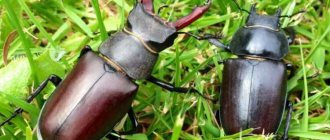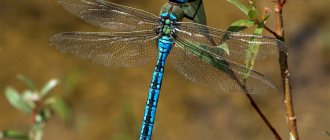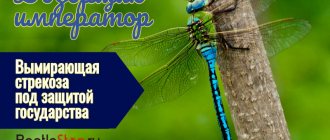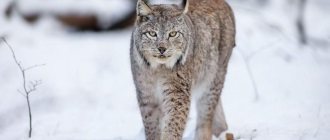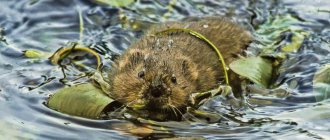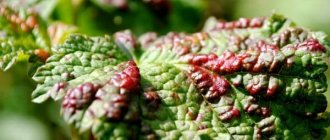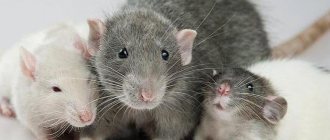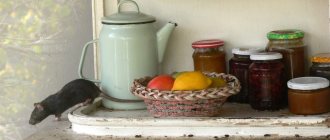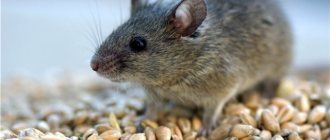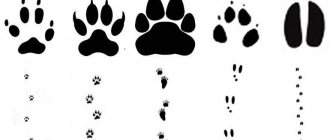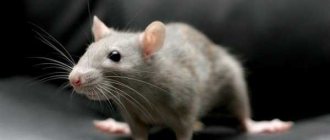Description and origin of the species
First scientific description and name of Castor zibethicus
The animal was given the name by the Swedish zoologist Carl Linnaeus in 1766. Since 1795, the animal was allocated to a separate monotypic genus of muskrats, and received the modern scientific name
Ondatra zibethicus.
Ondatra zibethicus is the only representative of the muskrat genus, and the Muskrat tribe Ondatrini. The animal belongs to the Hamster family Cricetidae, and is the largest representative of the Vole subfamily Arvicolinae.
The word "muskrat" was borrowed by the French from the language of the Huron Indians. The Indians called the animal ondathra.
The Latin name of the species,
zibethicus,
comes from the adjective
zibethus,
which is translated from Latin as musky.
The English name of the animal, muskrat, literally translates as musk rat. Initially, the muskrat was called the musk beaver, then, due to its similarity with the rat, it was renamed the musk rat. Despite the nicknames "rat" and "beaver", the muskrat does not belong to the genus Rat, and is not closely related to the beaver.
What does a muskrat look like?
Outwardly, the muskrat is similar to an ordinary rat, but noticeably larger - a musk rat is about 4 times heavier than a regular rat, although the body length of the animals differs slightly. The body length of an adult, including the tail, ranges from 40 to 70 cm, of which almost half, 18-28 cm, is the tail. The average weight of the animal is 1-1.5 kg. The musk rat is the largest and heaviest representative of the Hamster family, although it is much smaller in size than nutria and beaver.
The muskrat's body is quite heavy, has a short neck with a small head, and a blunt muzzle. The animal is well adapted to a semi-aquatic lifestyle. The eyes are small and high-set, small ears barely protrude from the fur. The lips, like those of beavers and nutria, are closed over the incisors, thanks to which the animal can gnaw plant stems under water without taking water into its mouth.
The fur of the animal is dense and short. The color varies from brown to almost black, with the fur on the belly usually being lighter than on the back. As the animal ages, gray hair appears. The fur has 2 layers - coarse guard hair and a soft, thick undercoat, which protects the animal from the cold when it stays in water for a long time.
The tail is long and covered with scales instead of fur. The animal actively helps itself with its tail while swimming, hence the unusual vertically pointed shape of the tail. When muskrats walk, they drag their tail along the ground, making their tracks easy to distinguish from other animals. The animal has webbed hind legs.
Meaning for humans
The skin of a muskrat is valuable for humans.
For humans, the muskrat is not the least important. Their skins have good strength, making them highly valued. They are used to make various warm clothes and use them around the house. In places where there is a high number of rodents, they are regularly caught. But this does not affect the animal’s population in any way: it reproduces faster than individuals fall into the hands of humans. In North America, muskrats are eaten. Its meat tastes like rabbit meat, but has a slightly different flavor.
However, in addition to the benefits, the rodent also brings harm. By digging deep holes, they can disturb the foundations of dams and damage agricultural fields. The animals are also capable of making constant raids on vegetable gardens, destroying most of the crop. What’s sad is that it’s impossible to combat this effectively.
The muskrat is a carrier of various diseases, including paratyphoid and tularemia. Therefore, it is recommended not to allow the rodent to bite you. Since he has an aggressive character and is not afraid to attack first, it is better to keep your distance from him. Fortunately, a muskrat is unlikely to be able to bite through the soles of thick shoes or thick pants. If the animal still manages to bite a person, you need to immediately go to the doctor and undergo the necessary tests.
Muskrat, nutria and beaver - how are they different?
The muskrat is much smaller in size than both the nutria and the beaver. The animal weighs only 1-1.5 kg compared to the 6-10 kg live weight of nutria, and 30-32 kg of beaver. The muskrat is also smaller in size. The body length of the musk rat does not exceed 40 cm, while the body length of the nutria is about 70 cm. The beaver is even larger - its body length varies from 1 to 1.2 meters.
In addition to their size, animals can be distinguished by their tail. The nutria's tail is thin, long, round in shape and covered with short hair. The muskrat's tail is also long and quite thin, but covered with scales with sparse hairs, and flattened vertically, thanks to which the animal actively uses it when swimming. The beaver has a powerful, muscular tail, covered with scales and horizontally flat, shaped like an oar.
Breeding
Muskrats are raised in private and special farms mainly to obtain skins for fur. Inexpensive fur coats, hats, and accessories are made from such raw materials. The fur is light, repels water well and lasts for several seasons. After 4–5 years of use, the products still lose their appearance.
The meat of the animals is also edible and in some places can be considered a delicacy. It tastes somewhat like hare meat and was formerly called “swamp rabbit.” In folk medicine, fat is used for rubbing. The secretion of the male glands, located on the stomach in the groin area, has a pungent musky odor. Animals use it to mark the boundaries of their territory. It can also be used in the perfume industry.
Muskrats and otters - what's the difference?
The muskrat and the otter are also often confused, but these are completely different animals and can be easily distinguished from each other.
- Muskrats and otters share a habitat - both species live in rivers and other bodies of water in North America and Eurasia. However, the habitat of otters is much wider - some species of otters inhabit Africa, Southeast Asia and South America, regions where there are no muskrats.
- Otters belong to the order of Predators, muskrats - to Rodents.
- Otters are several times heavier in weight and significantly larger in size.
- Otters eat fish, musk rats eat vegetation.
- The otter has a long, elongated, muscular body, typical of members of the Mustelidae family. The river rat is similar to a regular rat, only a little more massive.
- The otter has a long, thick tail, covered with thick, waterproof fur, like its body. The muskrat has a thin, long tail, covered with scales and flattened on the sides.
Where does the muskrat live?
The musk rat's historical range included only North America—most of Canada, the United States, and northern Mexico. At the beginning of the 20th century, the animals were brought to Europe and Asia. In Eurasia, animals have successfully adapted from Western Europe to China and Korea, including throughout Russia, from the border with Finland to the Siberian taiga, the Far East and Kamchatka. In the United States, the muskrat is not found only in Florida, where its habitat is occupied by another species - the round-tailed musk rat, or Florida water rat Neofiber alleni.
As a habitat, the musk rat inhabits rivers, lakes and ponds, and especially loves swampy lowlands and freshwater swamps. The animal prefers shallow water bodies, 1-2 meters deep, that do not freeze in winter and are covered with dense vegetation. The animals can live in man-made canals and irrigation ditches, abandoned quarries and near streams of sulfurous water flowing from flooded coal mines.
What does a muskrat eat?
The animal feeds mainly on plant foods, which accounts for about 95% of the diet. Animals eat coastal and aquatic vegetation - reeds, cattails, reeds, sedges, pondweeds, arrowheads and horsetails. In the spring, the animals eat young leaves and stems, in the summer they eat rhizomes and root parts, and in the summer they eat only rhizomes. Occasionally, muskrats eat small animals such as mussels, crustaceans, clams, frogs, fish and small turtles. On occasion, the animals do not hesitate to beg for food from people.
Nutrition
The food in the diet of these creatures is mainly of plant origin, and the animals are not at all picky when choosing dishes. To be more specific, it all depends on the place of settlement. The river muskrat happily eats aquatic and coastal greens with their tubers and roots.
Favorite delicacies include cattails, water lilies, horsetails, reeds, elodea, centurion, and watch. In summer, as well as in autumn, the choice of plants is especially varied and rich. By the way, such animals respect vegetables, if, of course, they can be found in the vicinity of their habitat. And in spring, the main dishes are most often reed stems, sedges, and fresh shoots of bushes.
But winter is an unusually difficult time. These aquatic inhabitants do not hibernate, but do not know grief, taking care of food supplies in advance. Such storage facilities are usually located in the most random underwater places of the inhabited area. In addition, muskrats look for roots of underwater flora at the bottom.
When plant food runs out, animal food is used: river carrion, half-dead fish, crustaceans, pond snails, mollusks. But if food becomes really tight, what does a muskrat eat in difficult times? Then, first, the animals begin to gnaw the walls of their houses made of plant materials.
There are also precedents for cannibalism among these representatives of the fauna, because they are quite aggressive and very brave. Most often, little warriors make underwater attacks, without hesitating to use their natural weapons: large teeth and sharp claws.
Character and lifestyle
Musk rats lead a semi-aquatic lifestyle and are active mainly at night and at dusk. Muskrats live in small family groups consisting of a male, a female and their young. In the spring, animals often fight among themselves over territory and potential partners, and fights often end in serious injury or death. Males mark their territory with musky secretions. Muskrats do not tolerate strangers and drive out grown cubs from their area. In spring and autumn, individuals without a site or partner migrate in search of free territory.
To protect themselves from the cold and predators, muskrats build dens. On the banks of a river, lake or other body of water, animals dig holes with an underwater entrance about 15-20 cm wide.
In swamps, animals build above-water dwellings from mud and vegetation - huts, up to 90 cm high. The entrance to the hut can be underwater or above water. In winter, the above-water entrance to the hut is plugged with grass and vegetation, which has to be changed frequently.
The third type of muskrat dwelling is floating open surface nests in swamps.
Muskrats do not store food for the winter, but in winter they occasionally feed on vegetation from their own hut. Animals occasionally steal beavers' supplies for the winter, although more often beavers and muskrats coexist peacefully in the same territory.
Muskrats are slow on land, but are excellent swimmers and divers. Animals can survive under water for 12 to 17 minutes. Like whales and fur seals, their bodies are less sensitive to carbon dioxide production than other mammals. The animal has excellent hearing, but relies much less on sight and smell.
Basic methods of struggle
To choose the most effective methods of pest control, you will need to understand each individual option.
It is important not to delay the process in order to preserve vegetables and other vegetation in the garden as much as possible.
Rat poison poisoning
Reading reviews from summer residents, you can understand that using poison is the most effective method for eliminating pests. The effect of the poison is massive and effective, but simply scattering the poison will not be enough. Water rats are smart, they immediately understand that they are trying to be destroyed. To obtain the expected results, the poison is disguised in bait using bread crumbs and other food. The finished product should be placed near holes or beds. If desired, you can buy special baits that are more effective than bread or vegetables.
Important! The main disadvantage of using poisons is that a rat can die anywhere on the site, so there is a risk of soil contamination with cadaveric poison. As soon as a water rat appears in the garden, you need to deal with it immediately. It is recommended to use one of three poisons
It is recommended to use one of three poisons.
Difa-Neo
A special grain bait that needs to be placed in holes and rat passages. It is often made from wheat soaked in chemicals. Manufacturers often use ethylphenacine for this.
Sold in the form of a paraffin briquette, which is perfect for places with high humidity.
Ratron Giftweizen
A fast-acting drug made in the form of granules. It is recommended to buy and use to get rid of pests very quickly.
Traps or snares
You can get rid of water rats in your area using traps and traps. They help quickly remove pests from the area, but the results will be positive with a small population.
Attention! After pests get into a trap or trap, it is necessary to quickly remove the corpse from the area. If this is not possible, then it is better to choose another liquidation option.
Mechanical
The method of disposal using mechanical traps is effective. Options include:
- traps;
- mousetraps;
- traps made according to various designs.
Adhesive
A good option for catching rats, but there is a drawback - the summer resident needs to constantly monitor the traps, check, and if the pest is caught, remove it. For the fight, such a measure turns out to be ineffective. Rats can get out of the sticky mass without much difficulty due to their size, which is larger than that of mice.
Electrical
Modern developments are also used in the production of pest traps. For these purposes, an electric valve is used, which can kill the animal with a discharge of current upon contact with the body of the pest. The method is effective, death occurs instantly, after discovering a corpse, you need to quickly remove it from the site.
Ultrasonic repellers
This option is humane, since under the influence of ultrasound the rats experience discomfort and begin to leave the area. The main disadvantage is that the process can be lengthy, because pests get used to the sounds. Well-thought-out repellers, whose sound range can be changed, help speed up the process.
Natural enemies
As soon as water rats appear in the garden, natural enemies come to the aid of the owners. The best cats are those that are able to eliminate animals very quickly. They love to hunt and in a few days they can destroy half of the entire livestock, the rest will go away on their own and will not return. However, not every cat is able to pick up the scent and kill a rat.
If the cat does not leave the apartment while spending time at the dacha, then you can use the contents of its tray. This option will be effective when filling the tray with wood filler on which the cat has urinated. It is recommended to bury the product shallowly in the ground. This will scare the rats, because they will think that a predator has appeared in the garden.
Rats are very sensitive to aromas, so improvised (folk) remedies have a positive effect if you want to get rid of them. Using simple methods, it is possible to influence the respiratory tract of rodents. So, there are both humane and aggressive means in which animals will suffocate or leave the area.
Reproduction and young
Like other rodents, muskrats reproduce very quickly. Females give birth 2-3 times a year. Pregnancy lasts on average 25-30 days, and there are 6-8 cubs in one litter. In the northern regions, animals breed only in the warm season - from March to August. In southern latitudes, reproduction practically does not stop, and the female can give birth up to 5 times a year. In the first weeks after birth, the male brings food to the female to increase the chances of survival of the offspring.
Baby muskrats are born hairless, blind and helpless, and weigh only about 22 grams at birth. On the 10th day, the babies already know how to swim; after 3 weeks, the cubs already eat plant foods. After 1 month, young muskrats become independent, but remain with their parents for some time. In warm climates, cubs leave their parents at the age of about six months; in cold northern latitudes, animals need up to 1 year to completely separate from the family. Animals reach sexual maturity at 7-12 months.
Natural enemies
Muskrats are an important food source for many predators. The animal is hunted by minks, elks, lynxes, wolves, foxes, cougars, raccoons, wolverines, bears, coyotes, snakes, eagles, hawks and alligators. In Eurasia, the common jackal hunts the animal more often than others.
Cayman turtles and monitor lizards, otters and herons, large frogs, pike and largemouth bass are not averse to feasting on baby muskrats. Elk, caribou and wapiti sometimes eat the vegetation from which musk rats' lodges are made in winter, depriving the animals of winter shelter.
Population and protection of the species
The number of muskrats in the wild is stable, although it changes cyclically every 6-10 years. Musk rats are listed as a species of least concern on the International Red Book. Animals were first brought to Europe in 1905; the animals came to Russia in 1928. Since then, aquatic rodents have successfully established themselves across the continent from western Europe to the Far East and China.
Muskrats adapt well to the environment and live successfully in man-made conditions - dams, canals, ditches. In many European countries, animals are considered pests. This is especially true for Belgium and Holland, where animals destroy the banks of canals, ponds, dams and dams, and also damage fishing nets. Muskrats are considered an invasive species and are prohibited from being imported into New Zealand.
Interesting Facts
There are many interesting facts associated with the muskrat.
- Indian tribes believed that it symbolizes cunning and true male friendship.
- In captivity, the animal lives almost 3 times longer.
- In some countries, it is considered a pest due to the fact that it successfully undermines dams and other protective structures. There individuals are mercilessly destroyed.
- This rodent serves as a carrier of a number of diseases dangerous to humans and domestic animals: Omsk hemorrhagic fever, paratyphoid fever, tularemia, salmonellosis, coccidosis, paratyphoid fever.
- In the reservoirs near which the rodent lives, the oxygen regime is favorable for wintering fish due to the blowing holes in the ice created by the animals.
- For unknown reasons, the population size decreases cyclically approximately every 7 years.
The muskrat is a very flexible species, which, after being introduced into a new biological system, managed to adapt to it without causing much harm.
